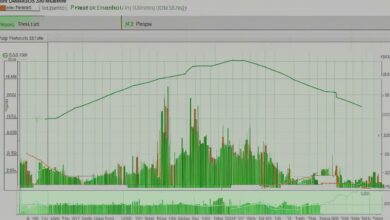The Role of Macro Events in Options Trading: Strategies for Navigating Economic Shifts

Introduction
Have you ever wondered how global economic shifts impact your options trading strategies?
Macro events refer to significant economic or geopolitical occurrences that can have widespread effects on financial markets. In the context of options trading, these events are crucial as they influence market volatility, investor sentiment, and the pricing of options. By understanding and anticipating macro events, you can develop strategies to navigate these shifts effectively.
Why do macro events matter in options trading?
- Market Volatility: Macro events often lead to significant price movements, which can create opportunities for profit.
- Investor Sentiment: Changes in economic conditions can drastically alter how investors perceive the market.
- Options Pricing: The valuation of options contracts is directly impacted by underlying asset price changes driven by these events.
Understanding the role of macro events in options trading equips you with valuable insights for optimizing your trading strategies amidst changing economic landscapes.
Understanding Macroeconomic Events
Macroeconomic events are large-scale economic occurrences that significantly influence financial markets, including options trading. These events stem from various factors such as government policy decisions, economic indicators, and geopolitical developments. Their impact on market volatility and investor sentiment makes them critical for traders to monitor.
Significance in Financial Markets:
- Economic Indicators: Data points like GDP growth rates, employment figures, and inflation reports provide insights into the health of an economy. Investors use these indicators to make informed decisions about their trades.
- Policy Decisions: Central bank actions, such as interest rate adjustments or quantitative easing measures, can lead to immediate market reactions. For example, a rate hike is generally perceived as bearish for equities but bullish for the currency.
- Market Volatility: Major economic announcements can lead to increased volatility. Traders often anticipate these movements and adjust their strategies accordingly.
Key Types of Macroeconomic Events Impacting Options Trading Strategies:
- Interest Rate Decisions: Central banks’ monetary policies directly affect the cost of borrowing and the valuation of currencies and assets.
- Inflation Reports: Rising inflation can erode purchasing power and impact corporate profits, influencing options pricing and volatility levels.
- Employment Data: Labor market statistics serve as a barometer for economic strength. Strong job numbers might boost market confidence, while weak data could spark concerns about economic slowdown.
- Geopolitical Events: Political instability, trade negotiations, or military conflicts introduce uncertainty into the markets, often leading to significant price swings in underlying assets.
Understanding these macroeconomic events allows options traders to develop strategies that align with anticipated market conditions.

Key Macroeconomic Events to Watch Out For
Interest Rate Decisions
Changes in interest rates hold significant sway over options pricing and market sentiment. Central banks, such as the Federal Reserve, adjust interest rates to control economic growth and inflation. When interest rates rise, borrowing costs increase, leading to reduced consumer spending and business investment. This generally results in a bearish market sentiment, impacting the underlying assets of options.
Impact on Options Pricing
Higher interest rates can increase the cost of carrying an option position, affecting both calls and puts. Conversely, lower interest rates may reduce these costs, making options more attractive.
Inflation Reports
Inflation data is crucial for shaping trader expectations and determining volatility levels. High inflation often signals a booming economy but can also lead to increased costs for businesses and consumers.
Trader Expectations
When inflation reports indicate rising prices, traders may anticipate tighter monetary policy from central banks to curb inflation. This can lead to heightened market volatility as investors adjust their positions.
Volatility Levels
Options traders often monitor inflation reports closely as they can be precursors to significant price movements in underlying assets.
Employment Data
Labor market indicators provide insights into economic health and potential market reactions. Key metrics include the unemployment rate, non-farm payrolls, and jobless claims.
Economic Health
Strong employment data usually reflects a robust economy which can boost investor confidence and lead to bullish market trends. Conversely, weak employment figures can signal economic slowdowns.
Market Reactions
Significant deviations from expected employment data can cause immediate reactions in the markets, impacting options pricing due to sudden shifts in supply and demand dynamics.
Geopolitical Events
Political instability or trade negotiations contribute to uncertainty in financial markets. Events such as elections, wars, or international treaties can drastically affect market conditions.
Uncertainty
Geopolitical events often introduce a high degree of uncertainty which can lead to increased volatility in financial markets. Traders might experience rapid changes in asset prices as they react to new information.
Options Activity
During times of geopolitical tension, you may notice heightened activity in options markets as traders seek protection or speculate on potential outcomes. Straddles and strangles become popular strategies for navigating this uncertainty.
Recognizing and understanding these key macroeconomic events are vital for any options trader looking to navigate economic shifts effectively.

Navigating Macroeconomic Events with Options Strategies
1. Hedging with Options
When macroeconomic events cause uncertainty, hedging strategies become vital tools for options traders. Protective puts and covered calls are two common strategies.
Protective Puts:
Traders use protective puts to hedge against adverse price movements. By buying a put option for an asset they already own, they secure the right to sell the asset at a predetermined price, thus limiting potential losses. During times of economic instability, such as unexpected interest rate hikes or geopolitical tensions, protective puts act as an insurance policy against significant downturns.
Covered Calls:
Covered calls involve holding a long position in an asset while selling call options on the same asset. This strategy generates income through premiums collected from selling the calls. It provides some downside protection since the premium income offsets part of any potential losses if the asset’s price declines. In periods of high volatility spurred by inflation reports or employment data releases, covered calls can be an effective way to earn additional income while managing risks associated with holding the underlying asset.
By employing these hedging strategies, you can navigate macro events in options trading more effectively, balancing risk and reward amidst economic shifts.
2. Capitalizing on Volatility with Options Strategies
Traders often turn to volatility-based strategies to navigate the unpredictable price swings that accompany macro events. Among these strategies, straddles and strangles are particularly effective.
1. Straddles
Straddles involve buying both a call option and a put option for the same underlying asset, with the same strike price and expiration date. This approach allows you to profit from significant price movements in either direction, making it ideal during periods of high uncertainty. For instance, before a major economic report is released, entering a straddle position can help capture gains whether the market goes up or down.
2. Strangles
Strangles, on the other hand, also involve purchasing both a call and a put option but with different strike prices. Typically, the call option has a higher strike price while the put option has a lower strike price compared to the current market price of the underlying asset. Strangles provide more flexibility and can be less expensive than straddles since options further out-of-the-money generally cost less.
Using these volatility-based strategies enables you to capitalize on substantial price movements without needing to predict the direction of those movements. This adaptability is crucial in macro events options trading, where rapid and unexpected shifts are common.
By incorporating straddles and strangles into your arsenal, you can better navigate the challenges posed by macroeconomic conditions and enhance your potential for profitable trades during periods of heightened volatility.
3. Event-Driven Trading in a Macro Context
Event-driven trading in the context of macro events focuses on capitalizing on anticipated economic shifts. One effective approach is pre-event positioning, where traders enter positions before major macroeconomic releases or announcements. By analyzing market expectations and historical data, you can strategically place trades to benefit from expected price movements.
Pre-event positioning
This strategy involves taking positions based on predicted outcomes of upcoming events. For instance, if you anticipate a central bank will raise interest rates, you might buy put options to hedge against a potential market downturn or employ call options to profit from a rally.
Equally important is adapting your strategy after the event occurs through post-event adjustments. This involves modifying trades based on actual outcomes versus initial expectations.
Post-event adjustments
Suppose an inflation report significantly deviates from market predictions. In such cases, adjusting your positions—either by closing out existing trades or initiating new ones—can help manage risk and capitalize on new opportunities.
Both hedging strategies and volatility-based strategies are integral to event-driven trading. Using protective puts provides downside protection, while covered calls generate income during uncertain periods.
By incorporating these approaches, you can navigate the complexities of macro events in options trading, enhancing your ability to respond effectively to economic shifts and market conditions.

Managing Risks in a Macroeconomic Landscape
Effectively managing risks during macroeconomic shifts requires robust diversification strategies. Diversifying across various asset classes helps mitigate the impact of specific macro events on your portfolio. This approach ensures that adverse movements in one asset class are counterbalanced by stability or gains in another.
Here are some key areas to consider for diversification:
- Equities and Bonds: Holding a mix of stocks and bonds can reduce the overall risk, as these assets often respond differently to economic changes.
- Commodities: Investing in commodities like gold or oil can provide a hedge against inflationary pressures or geopolitical instability.
- Currencies: Engaging in forex markets offers protection against fluctuations in currency values, especially during global economic shifts.
- Real Estate: Allocating a portion of investments to real estate can serve as a hedge against inflation and provide steady income streams.
By spreading investments across these diverse asset categories, you can better navigate the uncertainties posed by macroeconomic events, ensuring a balanced and resilient portfolio.
Case Studies: Learning from Past Macroeconomic Events in Options Trading
Financial Crisis Case Study
The 2008 Financial Crisis serves as a prime example of how macroeconomic events can dramatically impact options trading. During this period of heightened uncertainty, options traders employed several successful strategies to navigate the volatile market environment:
- Protective Puts: Many traders used protective puts to hedge against significant declines in stock prices. By purchasing put options, they gained the right to sell their shares at a predetermined price, limiting potential losses.
- Straddles and Strangles: These strategies allowed traders to profit from the increased volatility without predicting the exact direction of price movements. By buying both call and put options with different strike prices, traders capitalized on large price swings.
- Covered Calls: Some investors generated income and provided downside protection by selling call options on stocks they already owned. This strategy offered a buffer against minor declines while generating premium income.
These strategies highlight the importance of adaptability and foresight when navigating macroeconomic shifts in options trading.
Conclusion
Incorporating macro events into your options trading strategy can open up new opportunities. By understanding and predicting economic changes, you gain valuable insights and practical strategies to succeed in a constantly evolving market. Stay informed, remain alert, and make smart choices to navigate the ever-changing world of options trading effectively.







